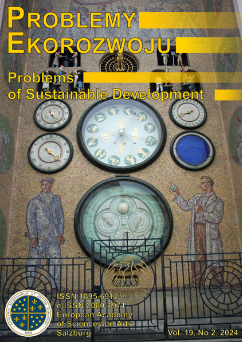The Analysis of Government Expenditures in the European Union
Florica Mioara Serban
Technical University of Cluj-Napoca, Department of Electrical Machines and Drives (Romania)
Carmen- Elena Stoenoiu
Technical University of Cluj-Napoca, Department of Electrical Machines and Drives (Romania)
Ciprian Cristea
Technical University of Cluj-Napoca, Department of Electrical Machines and Drives (Romania)
Abstract
This article analyses data on general government expenditure, at the level of the European Union (EU 28) according to the Classification of the Functions of Government – COFOG over the 2008-2017 period. Data shows that the expenditures increased at the beginning of the economic crisis in all EU countries, being followed by a slowdown in expenditures growth. All countries have adopted policies in order to reduce government expenditures towards the end of the period, aiming to increase their efficiency. Usually in high-income countries, compared with low-income countries, government expenditures are much larger as percent of gross domestic product (GDP), but the relations are not very strong though.
Keywords:
government expenditure, COFOG, Gross Domestic Product (GDP), EU 28References
ASCHAUER D.A., 1989, Is government spending productive?, in: Journal of Monetary Economics, 23, p. 177- 200.
DOI: https://doi.org/10.1016/0304-3932(89)90047-0
Google Scholar
BARRO R.J., 1990, Government spending in a simple model of endogenous growth, in: Journal of Political Economy, 98 S5, p. 103-125.
DOI: https://doi.org/10.1086/261726
Google Scholar
BARRO R.J., 1991, Economic growth in a cross section of countries, in: The Quarterly Journal of Economics, 106, p. 407-443.
DOI: https://doi.org/10.2307/2937943
Google Scholar
BECKER G.S., 1962, Investment in human capital: a theoretical analysis, in: Journal of Political Economy, Supplement, part 2, 70 (5), p. 9-49.
DOI: https://doi.org/10.1086/258724
Google Scholar
CASTRO V., MARTINS R., 2018, Politically driven cycles in fiscal policy: In depth analysis of the functional components of government expenditures, in:
DOI: https://doi.org/10.1016/j.ejpoleco.2017.11.003
Google Scholar
European Journal of Political Economy, 55, p. 44-64.
Google Scholar
EUROSTAT, 2019, Database, https://ec.europa.eu/eurostat/data/database
Google Scholar
GAMLATH S., LAHIRI R., 2018, Public and private education expenditures, variable elasticity of substitution and economic growth,in: Economic Modelling, 70, p. 1-14.
DOI: https://doi.org/10.1016/j.econmod.2017.10.007
Google Scholar
MARGINEAN I., 2014, Public expenditure with education and healthcare in EU countries, in: Procedia Economics and Finance, 8, p. 429-435.
DOI: https://doi.org/10.1016/S2212-5671(14)00110-5
Google Scholar
IFA A., GUETAT I., 2018, Does public expenditure on education promote Tunisian and Moroccan GDP per capita? ARDL approach, in: The Journal of Finance and Data Science, 4, p. 234-246.
DOI: https://doi.org/10.1016/j.jfds.2018.02.005
Google Scholar
KORMENDI R.C., MEGUIRE P., 1985, Macroeconomic determinants of growth: Cross country evidence, in: Journal of Monetary Economics, 16 (2), p. 141-163.
DOI: https://doi.org/10.1016/0304-3932(85)90027-3
Google Scholar
LUCAS R.E., 1988, On the mechanics of economic development, in: Journal of Monetary Economics, 22 (1), p. 3-42.
DOI: https://doi.org/10.1016/0304-3932(88)90168-7
Google Scholar
MAKSIMOVIĆ G., JOVIĆ S., JOVANOVIĆ R., ANIĈIĆ O., 2017, Management of healthcare expenditure by soft computing methodology, in: PhysicaA, p. 370-373.
DOI: https://doi.org/10.1016/j.physa.2016.08.035
Google Scholar
MLADENOVIC I., MILOVANCEVIC M., SOKOLOV MLADENOVIC S., MARJANOVIC V., PETKOVIC B., 2016, Analyzing and management of health care expenditure and gross domestic product (GDP) growth rate by adaptive neuro-fuzzy technique, in: Computers in Human Behaviour, 64, p. 524-530.
DOI: https://doi.org/10.1016/j.chb.2016.07.052
Google Scholar
SCHULTZ T.W., 1961, Investment in human capital, in: The American Economic Review, 51 (1), p. 1-17.
Google Scholar
VERGNE C., 2009, Democracy, elections and allocation of public expenditures in developing countries, in: European Journal of Political Economy, 25, p. 63-
DOI: https://doi.org/10.1016/j.ejpoleco.2008.09.003
Google Scholar
Authors
Florica Mioara SerbanTechnical University of Cluj-Napoca, Department of Electrical Machines and Drives Romania
Authors
Carmen- Elena StoenoiuTechnical University of Cluj-Napoca, Department of Electrical Machines and Drives Romania
Authors
Ciprian CristeaTechnical University of Cluj-Napoca, Department of Electrical Machines and Drives Romania
Statistics
Abstract views: 63PDF downloads: 13
License

This work is licensed under a Creative Commons Attribution-ShareAlike 4.0 International License.








